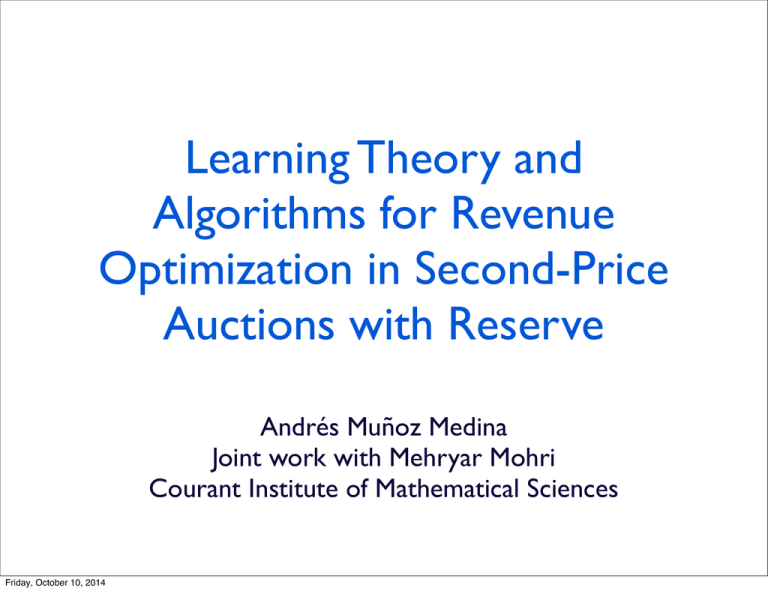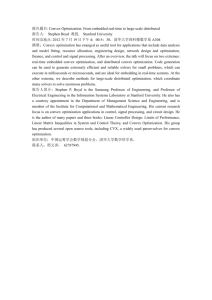Learning Theory and Algorithms for Revenue Optimization in Second-Price Auctions with Reserve
advertisement

Learning Theory and
Algorithms for Revenue
Optimization in Second-Price
Auctions with Reserve
Andrés Muñoz Medina
Joint work with Mehryar Mohri
Courant Institute of Mathematical Sciences
Friday, October 10, 2014
Second price auctions
Friday, October 10, 2014
Second price auctions
Friday, October 10, 2014
Second price auctions
Friday, October 10, 2014
Second price auctions
Friday, October 10, 2014
Second price auctions
Friday, October 10, 2014
Second price auctions
Friday, October 10, 2014
Second price auctions
Friday, October 10, 2014
Second price auctions
Friday, October 10, 2014
AdExchanges
Friday, October 10, 2014
AdExchanges
Friday, October 10, 2014
AdExchanges
Friday, October 10, 2014
AdExchanges
Friday, October 10, 2014
AdExchanges
Friday, October 10, 2014
Reserve prices
Friday, October 10, 2014
Reserve prices
Friday, October 10, 2014
Reserve prices
Friday, October 10, 2014
Motivation
✦
Online advertisement is a billion dollar
industry.
✦
Revenue of online publishers directly related to
AdExchanges.
✦
Several ads in AdExchange are sold at really
low prices or not sold at all.
✦
Current pricing techniques are naïve.
✦
Increasing number of transaction logs.
Friday, October 10, 2014
Related work
✦ Game-theoretic results and incentive
compatible mechanisms. [Riley and Samuelson ‘81, Milgrom and Weber ‘82,
Nisan et. al ’07, Blum et al. 03, Balcan et. al ’07]
✦ Estimation of empirical probabilities.[Cui et. al ’11, Ostrovsky
and Samuelson ’11]
✦ Bandit algorithm with censored information.
[Bianchi, Gentile and Mansour ‘12]
Friday, October 10, 2014
Outline
✦
Definitions
✦
Learning guarantees
✦
Algorithms
‣ No features
‣ General case
✦
Friday, October 10, 2014
Experimental results
Definitions
✦
Auction’s revenue depends on highest bids.
(1) (2)
b
=
(b
, b ), let
For bid pair
✦
Equivalent loss defined by:
Friday, October 10, 2014
Machine Learning
formulation
✦
✦
✦
✦
✦
Friday, October 10, 2014
x ∈ X : user information.
2
B ⊂ R : bid space.
H = {h : X → R}: hypothesis set.
D distribution over X × B.
Generalization error: E[L(h(x), b)] .
Machine Learning
formulation
✦
✦
✦
✦
✦
x ∈ X : user information.
2
B ⊂ R : bid space.
H = {h : X → R}: hypothesis set.
D distribution over X × B.
Generalization error: E[L(h(x), b)] .
Generalization bounds?
Friday, October 10, 2014
Loss function
✦
Non-differentiable.
✦
Non-convex.
✦
Discontinuous.
Friday, October 10, 2014
Learning Guarantees
Let (x1 , b1 ), . . . , (xn , bn ) be a training
sample, if d denotes the pseudo-dimension
of H , then with high probability for
every h ∈ H :
�
�
�
n
�
d
1
L(h(xi ), bi ) + O
E[L(h(x), b] ≤
n i=1
n
✦
✦
Friday, October 10, 2014
How can we effectively minimize this loss?
Algorithms
Friday, October 10, 2014
No feature case
✦
Find optimaln reserve price.
min
r∈R
�
L(r, bi )
i=1
✦
Optimal reserve is one of
highest bids.
✦
Naïve O(n2 )
✦
Sorting O(n log n)
Friday, October 10, 2014
Algorithm idea
(2)
−(b1
(2)
+ b2 )
(2)
−b2
0
0
Friday, October 10, 2014
−
−
−
−
(2)
(0)b1
(2)
(1)b2
(1)
(2)b1
(2)
(1)b1
Surrogate Loss
Friday, October 10, 2014
Surrogate Loss
✦
Friday, October 10, 2014
Theorem: There exists no consistent convex
surrogate loss that is not constant.
Continuous surrogate
Friday, October 10, 2014
Consistency results
✦
Define:
✦
Theorem: Let M = sup b and H be a Banach
b∈B
space. If h∗γ = argminh E[Lγ (h(x), b)], then
(1)
∗
E[L(hγ (x), b)]
Friday, October 10, 2014
≤
∗
E[Lγ (hγ (x), b)]
+ γM
Learning Guarantees
✦
Let (x1 , b1 ), . . . , (xn , bn ) be a training
(1)
sample and M = sup b . With high probability
b∈B
for every h ∈ H :
1
E[Lγ (h(x), b] ≤
n
Friday, October 10, 2014
n
�
2
Lγ (h(xi ), b) + �n (H) + M
γ
i=1
�
log 1/δ
2m
Optimization via
DC-programing
✦ Lγ
Friday, October 10, 2014
is a difference of convex functions.
Optimization via
DC-programing
✦ Lγ
Friday, October 10, 2014
is a difference of convex functions.
Optimization via
DC-programing
✦ Lγ
Friday, October 10, 2014
is a difference of convex functions.
Optimization via
DC-programing
✦ Lγ
Friday, October 10, 2014
is a difference of convex functions.
Optimization via
DC-programing
✦ Lγ
Friday, October 10, 2014
is a difference of convex functions.
Optimization via
DC-programing
✦ Lγ
Friday, October 10, 2014
is a difference of convex functions.
DC-programming
algorithm
[Tao and Hoai ’97]
✦
Idea: Sequentially minimize upper bound on
function.
✦
If F (w) = f (w) − g(w) . The following iterates
converge to a local minimum:
wt+1 = argminw f (w) − g(wt ) − ∇g(wt ) · (w − wt )
✦
Friday, October 10, 2014
Matches CCCP algorithm. [Yuille and Rangarajan ’02]
Line-search
✦
Function Lγ positive homogeneous
Lγ (tr, tb) = tLγ (r, b)
✦
Fix direction w0
✦
Rewrite
n
�
i=1
✦
Friday, October 10, 2014
�
Lγ (λw0 xi , bi ) =
n
�
i=1
∀t > 0
�
�
w0 xi Lγ λ,
bi
w0 � x i
Equivalent to no-feature minimization.
�
Algorithms
✦
No Features
✦
Regression
✦
Convex surrogate
✦
DC
Friday, October 10, 2014
Experimental results
50
DC
Convex
50
DC
Ridge
40
Improvement %
Improvement %
40
30
20
10
0
200
Friday, October 10, 2014
30
20
10
0
−10
300
400
600
800 1200 1600 2400
−20
200
300
400
600
800 1200 1600 2400
Experimental Results
2
1.8
Revenue
1.6
1.4
1.2
1
0.8
DC
Convex
No Features
200 300 400 600 800 12001600 2400 3200
Friday, October 10, 2014
Realistic data
Surrogate
31.73
Friday, October 10, 2014
No Feat
29.58
DC
37.19
Lowest
29.53
Highest
52.85
Conclusion
✦
Machine learning is crucial for revenue
optimization.
✦
Extension to GSP
✦
Better DC algorithm?
✦
Better initialization
Friday, October 10, 2014



